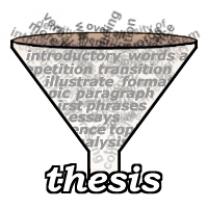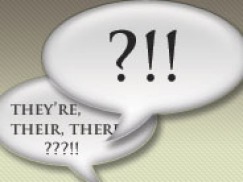COMMON ERRORS IN WRITING

Navpreet Hehar
In the writing process there are many common errors one comes across. These errors can make a paper lose credibility or lose the interest of the reader. One critical error is the organization of the paper. If the paper is not organized the reader could get confused and not understand what the author is talking about. Organization is the backbone of a paper and without it the paper would fall apart. Making an outline is one way to ensure the correct organization of a paper. This allows one to organize paragraphs accordingly to make sure they all flow together. It is also helpful to have someone else read your paper to check for organization and other errors.
Another common error in the writing process is the use of quotations. In APA style, quotations longer than 40 words must be placed in a "free standing block" as stated by The Owl. Start the quotation on a new line and indent 5 spaces from the margin. Omit any quotations and indent each line 5 spaces. Once the quote is stated, the citations should be listed followed by a period or other punctuation mark. An example is provided at the following site: http://owl.english.purdue.edu/owl/resource/560/02/
Writing in the correct tense is another common error that occurs in the writing process. It is important to maintain the correct tense throughout a paper/sections of a paper. In APA style, a paper should be in the past tense. When writing a research paper the methods, results and discussion section of the paper all must be in a certain tense. The method section is written in the present tense, the results section is written in the past tense and the discussion section is written in the present tense. Tense should be consistent within a paragraph otherwise the reader could find it annoying and lose interest. The best way to check for this error is to have someone else review your paper.
In the writing process there are many common errors one comes across. These errors can make a paper lose credibility or lose the interest of the reader. One critical error is the organization of the paper. If the paper is not organized the reader could get confused and not understand what the author is talking about. Organization is the backbone of a paper and without it the paper would fall apart. Making an outline is one way to ensure the correct organization of a paper. This allows one to organize paragraphs accordingly to make sure they all flow together. It is also helpful to have someone else read your paper to check for organization and other errors.
Another common error in the writing process is the use of quotations. In APA style, quotations longer than 40 words must be placed in a "free standing block" as stated by The Owl. Start the quotation on a new line and indent 5 spaces from the margin. Omit any quotations and indent each line 5 spaces. Once the quote is stated, the citations should be listed followed by a period or other punctuation mark. An example is provided at the following site: http://owl.english.purdue.edu/owl/resource/560/02/
Writing in the correct tense is another common error that occurs in the writing process. It is important to maintain the correct tense throughout a paper/sections of a paper. In APA style, a paper should be in the past tense. When writing a research paper the methods, results and discussion section of the paper all must be in a certain tense. The method section is written in the present tense, the results section is written in the past tense and the discussion section is written in the present tense. Tense should be consistent within a paragraph otherwise the reader could find it annoying and lose interest. The best way to check for this error is to have someone else review your paper.

Jaspreet Hehar
Although not everyone writes the same, some common errors are faced by many individuals. These errors are relatively easy to fix if you know what you are looking for while proofreading.
Although not everyone writes the same, some common errors are faced by many individuals. These errors are relatively easy to fix if you know what you are looking for while proofreading.
- Transition Sentences – when moving from one paragraph to the next, many individuals do not create clear transition sentences. As a consequence, this disrupts the flow of the paper. Transition sentences should conclude one paragraph, and introduce the next. In order to create better transition sentences, I practiced writing thesis statements for each new paragraph and connected this sentence to the conclusion of the paragraph preceding it. With practice, writing these sentences will become easier.
- Thesis Statement – this sentence is usually found in the introduction of the paper. Its primary function is to basically discuss the contents of the essay all in one or two sentences. Many individuals do not create a clearly defined thesis statement, and so the subject/purpose of the paper is unknown to the reader. When I write a thesis statement, I usually write it after the entire essay has been written. This way, I can ensure that I do not forget to include every topic of my paper in the statement. The following link does a great job in describing how one can create an excellent thesis statement for their paper: http://owl.english.purdue.edu/owl/resource/545/01/.
- APA/MLA Guidelines – one of the most difficult aspects of writing a paper is following either APA or MLA guidelines. Depending upon what field you are writing in, each style of writing has its own rules in composing a paper. The sciences (biology, chemistry, political, etc...) usually follow guidelines set by the American Psychological Association (APA), while other areas such as history and English follow rules set by the Modern Language Association (MLA). These rules change from year to year, and so writers have difficulty keeping up to date with the changes. One of the most difficult aspects people face when writing in these styles is citing sources according to the guidelines. The website above has an excellent source of information that helps in learning the APA and MLA styles of writing.
Kathleen Beydoun

There are many errors that can occur when one is attempting to write an essay. One may have trouble with proper grammar. Some common mistakes include the confusion of “your” versus “you’re.” “Your” is a possessive pronoun, while “you’re” is a contraction for “you are.” It is also very common for one to confuse “affect” with “effect.” “Affect” is a verb, while “effect” is a noun. Some may also have trouble being consistent with their tense. One might switch from present tense to past tense without realizing it. It may confuse the reader and make their writing questionable. How can one’s writing be convincing if he/she are unable to write properly? One may also have a lack of agreement between pronouns and antecedents. For example, one may state “Each of the kittens was welcomed in their new home” should be “each of the kittens was welcomed in its new home.” If I am writing an essay and I begin with saying “one must be sure to…” then I have to make sure that I do not change “one” to “their” or “they.” If I am referring to someone as a single person, I must continue to do so throughout my essay.
Michael Osman
APA
Students usually have a hard time following the rules of style guides (APA, MLA, etc.) When it comes to APA, there are many rules such as paper formatting, in-text citations, referencing, and basic rules. Some common APA errors include:
Bolding or Italicizing when not needed
Writing numerals or numbers
Capitalize or lower-case
Comma or Semi-colon
Avoid using sexist words such as “he” or “his.”
Ex: “When the subject reported being finished, the experimenter asked him to complete a second questionnaire.”
Do not combine singular and plural forms of words in the same sentence.
Ex: Each subject rated their own mood on the questionnaire.
Do not write fragmented sentences. Every sentence needs a subject and a predicate.
Ex: "Such as English."
Students usually have a hard time following the rules of style guides (APA, MLA, etc.) When it comes to APA, there are many rules such as paper formatting, in-text citations, referencing, and basic rules. Some common APA errors include:
Bolding or Italicizing when not needed
Writing numerals or numbers
Capitalize or lower-case
Comma or Semi-colon
Avoid using sexist words such as “he” or “his.”
Ex: “When the subject reported being finished, the experimenter asked him to complete a second questionnaire.”
Do not combine singular and plural forms of words in the same sentence.
Ex: Each subject rated their own mood on the questionnaire.
Do not write fragmented sentences. Every sentence needs a subject and a predicate.
Ex: "Such as English."

Ernada Doko
There are many common errors made by students when writing that are present in all writing styles. One common error is the information presented is poorly organized. Many students do not compose a preliminary outline that organizes their ideas in a fluent manner. Therefore, the paper is not cohesive and jumps from one idea to another, making it difficult to understand the purpose of the paper. Another common mistake is that the writing does not contain a strong and clear thesis statement that tells the reader the purpose of the paper and connects the main ideas together. Without this essential statement, the reader is forced to guess the main ideas and the purpose of the paper. A third prevailing error is the lack of transition sentences. Transition sentence are crucial in leading readers from one idea to another. Without transition sentences, a paper seems very choppy and unrelated. Many writers make the mistake of not ending one paragraph with a sentence that leads to the next paragraph and beginning new paragraph with a sentence that relates to the previous paragraph. Lastly, a very common mistake made is writing in the wrong tense. This is especially vital when students have to write in a certain style such as MLA, APA, and Chicago style. Each styles demands a certain tense for each section, and many students do not utilize the appropriate tenses.
There are many common errors made by students when writing that are present in all writing styles. One common error is the information presented is poorly organized. Many students do not compose a preliminary outline that organizes their ideas in a fluent manner. Therefore, the paper is not cohesive and jumps from one idea to another, making it difficult to understand the purpose of the paper. Another common mistake is that the writing does not contain a strong and clear thesis statement that tells the reader the purpose of the paper and connects the main ideas together. Without this essential statement, the reader is forced to guess the main ideas and the purpose of the paper. A third prevailing error is the lack of transition sentences. Transition sentence are crucial in leading readers from one idea to another. Without transition sentences, a paper seems very choppy and unrelated. Many writers make the mistake of not ending one paragraph with a sentence that leads to the next paragraph and beginning new paragraph with a sentence that relates to the previous paragraph. Lastly, a very common mistake made is writing in the wrong tense. This is especially vital when students have to write in a certain style such as MLA, APA, and Chicago style. Each styles demands a certain tense for each section, and many students do not utilize the appropriate tenses.
Mazen Zein
There are many different common errors in writing that one might perform when writing. For example, errors in the use of an apostrophe to show the difference in possession or the plural form of a word. Errors in quotation, such as where to put punctuation marks when finishing a quote, whether it should be within the quotation marks or not. Another error in writing that might be a little more significant would be transitioning from paragraph to paragraph. This is very important because it when writing a paper, one must give clear statements that will allow the reader to move from one major topic to the next. With errors in this, the reader will not be able to comprehend the information, and the paper itself will not be organized. Many of the common errors that have been listed can be avoided through basic proofreading. Or allowing others to read one's work to get a second opinion.
